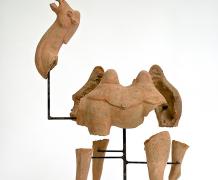“China is a sleeping giant. Let her sleep, for when she wakes, she will move the world.”
––Napoleon Bonaparte
Fractured pottery shards are glued together by golden rivulets, molten metal runs across fault-lines like glowing lava streams on a volcanic plain. They become map lines, raised scars, a documentation of past trauma. Where they are not glued back together, objects sit, blown apart, held forever in stasis, neither whole nor shattered, a frozen instant in time in which one single defining moment of violence and pain metamorphoses into a soulful, beautiful future. In the works of London-based Dutch artist Bouke de Vries, destruction leads not to the end, and pain does not mean failure, but, rather, a new beginning. In imperfection lie hope, strength and beauty. Fractured Images (9 June–15 July 2017), marks his first solo show at Kristin Hjellegjerde and features new works and original sculpture focusing on the ceramic history of China, the largest producer of ceramics the world has ever known.
In Fractured Images, de Vries examines the powerful role China has played not just as a major producer, but as an influence on the art of ceramics throughout the world. From the Islamic pottery of the Middle East and Persia to the birth of the iconic willow pattern and Chinoiserie of 18th-century Britain and the art of Dutch Delftware, China has been the biggest single influence in the history of ceramics.
His work is also intrinsically linked to his experience as a ceramics conservator, imbuing historic pottery with new life. De Vries laments the underlying Western attitude that once something is broken it is only fit to be discarded; instead he chooses to celebrate the Chinese and Japanese tradition of repairing important objects so that the breakage is celebrated, rather than hidden. “I wanted to give these objects, which are regarded as valueless, a new story and move their history forwards,” he has said. “A broken object can still be as beautiful as a perfect object.”
As such, there is beautiful destruction and renewal everywhere: the breaks in a Chinese Han Dynasty cocoon jar are restored and celebrated with the golden fault-lines of the Japanese art of Kintsugi. An accompanying photograph of the vase in the broken state in which the artist originally found it lays out each fragment like an autopsy of body parts, a vision into the power of reconstruction and healing. Another such cocoon pot floats instead in a permanent state of being torn apart yet together. It is an explosion in bloom, adorned with butterflies in a nod to Dutch still lifes, with the creatures that symbolise rebirth. Similarly, Tang-dynasty figures are reconstructed on wire frames like strong, new skeletons; their missing parts only making the rest seem more solid: a horse and rider are able to carry on, and a camel, that ship of the desert upon which so many loads of ceramics were transported along the Silk Road over the cent
Bouke de Vries
Kristin Hjellegjerde Gallery 533 Old York Road Wandsworth

Ad
Event has ended
This event ended on Saturday 15th of July 2017
This event ended on Saturday 15th of July 2017
Admission
Free
Free
Tags:
Art
User Reviews
There are no user reviews
